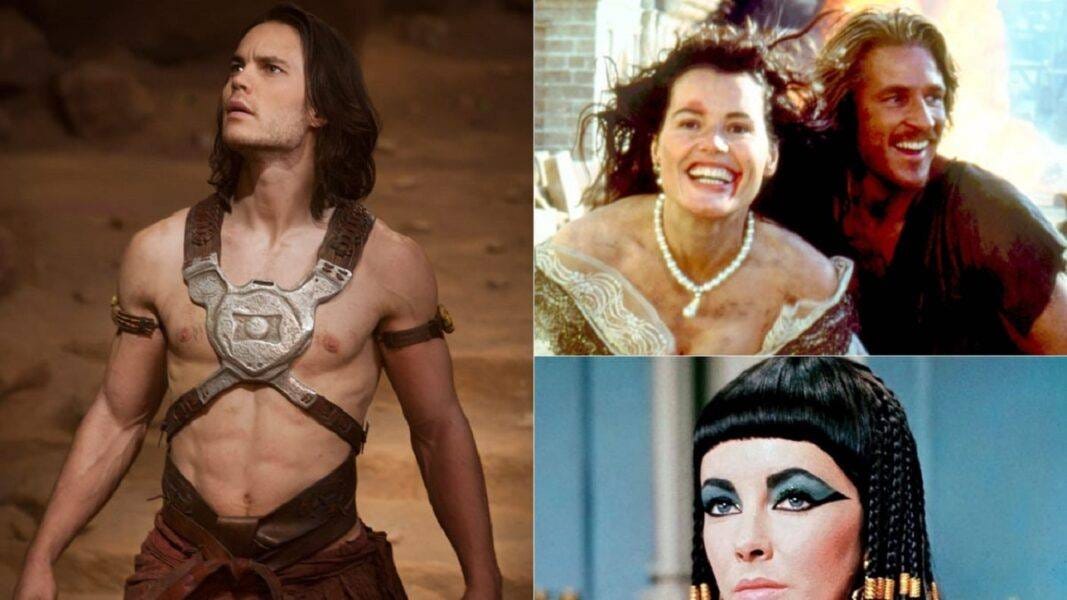Hollywood’s Biggest Gambles: Hits and Misses
Click to read the full story: Hollywood’s Biggest Gambles: Hits and Misses
Hollywood attracts as many gamblers as casinos, but it doesn’t have as much luck as its long history of box office hits and bombs is as varied as Donald Trump’s twitter feed. The one main difference between Hollywood studios and casinos is that unlike casinos, where the house always wins, it’s not always the case with movie studios.
Trying to predict a box office hit is about as random as trying your luck with the lottery. At least with online casino games, your luck is often much much better. Sometimes you hit the big one, and that thrill in trying to get your big win is what gets the adrenaline pumping. Much like how those studio heads feel trying to determine that must-see box office smash in order to keep their job. Hollywood is littered with long-forgotten names of those that were sure they had a hit, and we’re digging into those along with those huge gambles that paid off bigger than anyone thought possible.
Gambles That Broke the Bank
“Kick-Ass”
Director Matthew Vaughn saw something in the genre-bending comic book movie that no one else did. In fact, he mortgaged his home to get it made while one studio after another said no. “Kick-Ass” was based on a comic-book no one had heard of because it hadn’t been completed, but the story of an average teenager who decides to become a superhero pushed Vaughn to take the huge gamble.
“They weren’t even intrigued,” Vaughn says. “Literally every person who saw it or read the script said, ‘No. No studio would touch it, so I had to mortgage my house in order to finance the film, which was scary, to be honest.”
“Kick-Ass” wasn’t just an in your face reimagining of comic books, it rewrote the formula on how comic book movies were made earning $96.2 million worldwide with a $28 million budget. The controversy it sparked helped build a bigger audience while also paving the way for future comic book films like “Kingsman: The Secret Service (2015, also directed by Vaughn) and Ryan Reynold’s “Deadpool” (2016).
“Avengers” Marvel Cinematic Universe (MCU)
After making more than $18.6 billion worldwide at the box office, it’s hard to remember that the Marvel Cinematic Universe started as one huge gamble twelve years ago. It all began with 2008’s “Iron Man,” the first film in the MCU, and never having appeared in a movie or even TV show, it was far from a guaranteed hit. At the time, DC Comics “Dark Knight” trilogy was sweeping the box office.
To make things even more unsure, Marvel brought in Robert Downey, Jr. (who couldn’t be insured in the late 1990’s with all his personal issues) and director Jon Favreau, whose main experience was “Elf.” The studio decided to jump in with both feet and co-star Jeff Bridges let himself relax and view the chaotic productions as a “$200 million student film.”
“Iron Man” began the long journey as the first of this new series of Marvel-made movies. “I really don’t know how people are gonna react to this thing,” Favreau admitted shortly before the film’s release. “This could be anything from a flop to … something beyond people’s expectations. You never know.”
Kevin Feige’s Gamble
Marvel’s studio head Kevin Feige was all in on this major gamble by putting comic book superspy Nick Fury (Samuel L. Jackson) into the final scene of “Iron Man”. With this simple addition, the Marvel Cinematic Universe was born, and this began the trend for postcredits scenes while setting the stage for more MCU superheroes to hit the big screen.
While “Iron Man” was a huge hit with critics and fans, the MCU wasn’t all smooth sailing. The second film in the series “The Incredible Hulk,” opened to a rather tepid reception as it still remains the weakest box office performer in the twenty-two film franchise.
Chris Hemsworth played the mighty “Thor,” while Chris Evans stepped into “Captain America: The First Avenger” tights in 2011. These were huge hits, but the studio was about to find out if their gamble would pay off with the first “Avengers” movie bringing the characters together into one film while also introducing others. It hit the big screen in 2012 in a big way and brought in over $1.5 billion worldwide. Seventeen more films were made ending with “Avengers: Endgame,” which smashed box office records.
“Titanic”
While many only know how big “Titanic” was at the box office, the studios at the time were terrified that the most expensive film of the 1990’s would sink them. While James Cameron was bringing in the hits with “Terminator 2: Judgement Day,” and “True Lies,” his next film about the famous sinking ship cost more than both of this last two films put together. A recent bomb “Waterworld” (starring and directed by Kevin Costner), which cost $175 million taught studio heads to never shoot on water, but Cameron had three sound stages in use. Yes, and one of them was on water.
Back then, Leonardo DiCaprio and Kate Winslet were not well known which only made the studio more nervous. Soon, “Titanic” was the talk of Hollywood, but not in the good way. This only made Fox Studios nervous so they brought in Universal to pick up non-American rights in distributing the film. Fox studio chief Bill Mechanic was coming under pressure from his ultimate boss – Rupert Murdoch – to get results. As Mechanic would say of Titanic, “everybody thought the movie was nuts”.
When the Universal deal failed to pan out, Fox sold the American distribution rights to Paramount Pictures for a deal price of $65 million. Deal, you say? Yes, it was a huge win for Parmount as the U.S. box office take for the film was $659 million, making it one of the highest grossing films in the studios history.
Not to mention all those Oscar statues the film won along with the mint made on home video. This was easily one of the best gambles in Hollywood history.
“Tenet”
Christopher Nolan’s latest mind-bending thriller was put on the shelf when the Coronavirus pandemic hit, and the studio was at a loss on what to do. Did they go the Disney route and live-stream “Mulan,” or wait in hopes that theaters would re-open? The film was supposed to open in mid-summer, but the studio waited until the end of August, to see it hit the top of the box office charts worldwide. “Tenet” didn’t open as big as Nolan’s other films, but $20.2 million in North America is looking to be the new norm for 2020.
Gambles That Broke the Studio
Hollywood legend would have some believing that the biggest box office gambles of all time would be Elizabeth Taylor’s epic disaster “Cleopatra” or Michael Cimino’s 1980 flop “Heaven’s Gate.” Cimino’s easily holds it’s own in the top 10 as the shoot lasted ten months driving up the production budget to $171 million in today’s world. It only earned $3.5 million domestically forcing United Artists to take a $128 million hit. Yes, there have been even bigger disasters.
“Cutthroat Island”
One of the most famous box office flops as is was crowned the “largest box office loss” by Guinness World Records and led to the collapse and demise of Carolco Pictures. 1995’s “Cutthroat Island” was always in trouble and costs were out of control. The budget wound up going north of $125 million while earning only $15.7 million worldwide giving is a loss of $118 million.
“King Arthur: Legend of the Sword”
This film was most famous for featuring football star David Beckham, but Guy Ritchie’s attempt to kickstart a new franchise came with a huge budget and a stinker for Charlie Hunnam. The production budget rose to $175 million while “King Arthur: Legend of the Sword” opened in America to just $15 million giving the studio a loss of $150 million.
“John Carter”
The buzz on Disney’s sci-fi epic “John Carter” was horrible long before it opened. When word got out that the budget was over $260 million, everyone was shocked. The live action fantasy film had no big stars, and it was based on a novel (Edgar Rice Burrough’s “John Carter of Mars”) that was mainly known only by hardcore geeks. Many assumed Disney lopped off the Mars from the title as they were still licking their wounds from their 2011 mega flop “Mars Needs Moms” which cost the studio over $100 million.
“John Carter” opened to horrible reviews and only $30 million in North America. Disney took another Mars hit to their bottom line for a $200 million write-down. That actual loss was $136.6 million.
“Sinbad: Legend of the Seven Seas”
Brad Pitt and Michelle Pfeiffer couldn’t save this 2003 Dreamworks animated movie from technology. While critics gave some positive comments to the film, audiences had been fixated by Pixar’s “Finding Nemo,” which had come out prior to this one. If you’d not heard of this one, don’t be surprised as many haven’t.
After this, Dreamworks abandoned their traditional hand-drawn movies and went headlong into computer-generated animation. “Shrek 2” more than made up for this loss.
The post Hollywood’s Biggest Gambles: Hits and Misses appeared first on Movie TV Tech Geeks News By: George Cando








